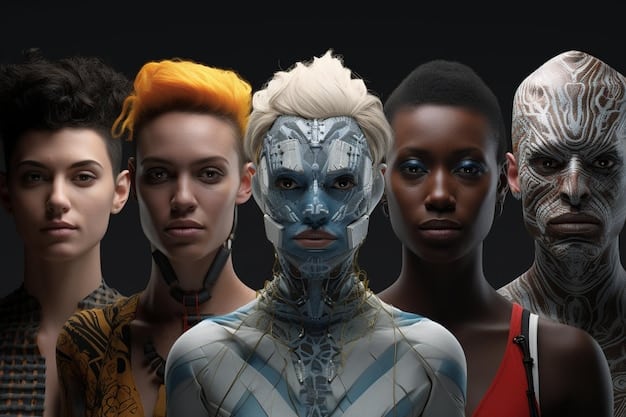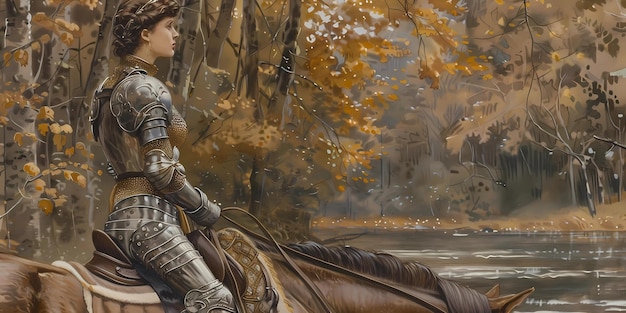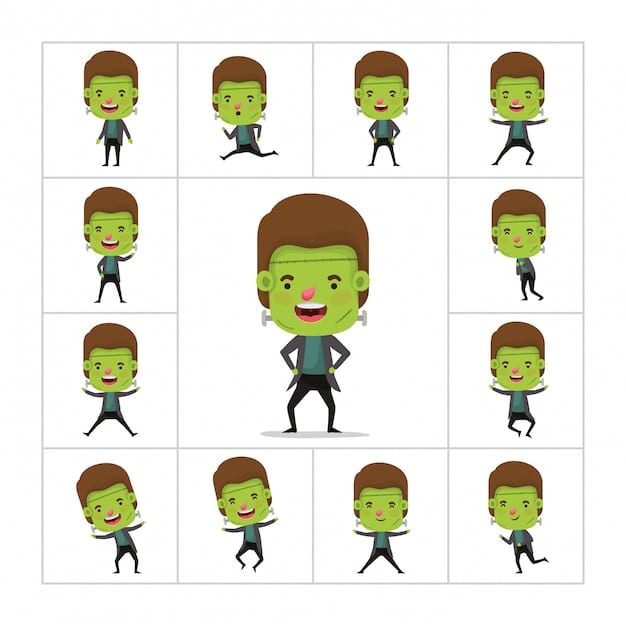Creating Compelling Game Characters: Step-by-Step Guide

Crafting compelling game characters is essential for player immersion and narrative depth, requiring a methodical approach encompassing backstory, visual design, and gameplay integration to ensure memorability and engagement within the game’s universe.
In the expansive and ever-evolving world of video games, mere pixels and polygons aren’t enough to capture hearts and minds. What truly resonates are the figures that inhabit these digital realms, the characters whose stories we unravel, whose challenges we share, and whose triumphs often feel like our own. Creating Compelling Game Characters: A Step-by-Step Guide to Character Design is not merely about sketching an avatar; it’s about breathing life into an entity that will drive narrative, define player experience, and ultimately, leave an indelible mark on the gaming landscape.
Understanding the Core of Character Design
Before any lines are drawn or models sculpted, the foundation of a compelling character must be laid in concept. This initial phase is often the most critical, as it dictates the very essence of who the character is and what role they will play within the game’s ecosystem. It’s about delving deep into the ‘why’ before hitting the ‘how’. A character isn’t just a collection of traits; they are an amalgamation of purpose, past, and potential.
Character design begins with understanding the game’s genre and narrative. A character for a high-fantasy RPG will require a different approach than one for a sci-fi shooter or a whimsical puzzle game. The world dictates the character, and the character, in turn, helps to define the world. Consider how the character fits into the overarching storyline and what narrative functions they need to fulfill. Are they the protagonist, an antagonist, a wise mentor, or a comic relief sidekick? Each role carries specific design implications.
Defining the Character’s Archetype and Role
Every compelling character often aligns with certain archetypes, providing a recognizable framework for both creators and players. While originality is key, drawing from established archetypes can offer a strong starting point and a shared understanding. This isn’t about creating clichés, but rather using archetypal elements as a springboard for unique expression.
- The Hero/Heroine: Often embodies courage, selflessness, and a quest for justice. Their journey is typically one of growth and overcoming internal and external obstacles.
- The Villain/Antagonist: Not merely evil, but often driven by complex motivations, fears, or warped ideals. A truly compelling villain mirrors the hero in some way or represents a thematic challenge.
- The Mentor: Provides guidance, wisdom, and often a spiritual or practical lesson. They are typically older and embody a sense of calm authority.
- The Trickster: Disrupts conventions, often uses wit and cunning, and can be unpredictable. Their role is to challenge norms and introduce chaos or unexpected solutions.
Beyond archetypes, a character’s specific role in the game’s mechanics is paramount. How do they interact with the game world and other characters? What unique abilities or limitations do they possess that factor into gameplay? Understanding these aspects early on ensures that the character’s design serves both narrative and functional purposes, preventing them from becoming merely static figures in a dynamic environment.
Ultimately, the core of character design is about establishing a foundation that is both robust and flexible. It’s an iterative process where initial ideas are refined, challenged, and reshaped until a coherent and compelling vision for the character emerges. This initial conceptual work, though invisible to the player, is the bedrock upon which all subsequent design decisions will rest, setting the stage for a truly memorable character experience.
Developing a Rich Backstory and Personality
A character, much like a person, is a product of their experiences, relationships, and the environment they inhabit. A rich backstory isn’t just a collection of historical facts; it’s the invisible thread that weaves through a character’s personality, motivations, and even their appearance. This depth transforms a flat entity into a three-dimensional being that players can connect with on an emotional level. Without a compelling internal world, even the most visually striking character can feel hollow.
Start by considering key life events that shaped the character. What were their formative years like? Did they face hardship, enjoy privilege, discover a hidden talent, or suffer a significant loss? These events should not just be listed, but explored for their impact. How did they change the character? Did they instill a particular fear, a strong conviction, or a unique skill? The answers to these questions will begin to sculpt their personality.
Crafting Motivations and Flaws
Every character, especially a compelling one, must have a clear set of motivations. What drives them? Is it revenge, love, power, salvation, knowledge, or simply survival? Strong motivations provide purpose for the character’s actions and make their journey engaging. Their goals should be tangible and consequential, creating conflict and drama within the narrative. Motivations can evolve throughout the game, revealing layers of complexity as the player progresses.
Crucially, no truly compelling character is perfect. Flaws are not weaknesses to be hidden, but rather opportunities for relatability and growth. A character’s flaws make them human (or alien, or fantastical, but relatable in their imperfection). Are they arrogant, impulsive, overly trusting, cynical, or prone to self-doubt? These imperfections create internal conflict and often serve as catalysts for plot development. The struggle against their own flaws can be as compelling as any external adversary.
- Primary Motivation: The overarching goal that fuels the character’s journey. (e.g., finding a lost family member, saving the world).
- Secondary Motivations: Smaller, often immediate goals that contribute to the primary one or provide sidequests. (e.g., earning money, gaining a specific skill).
- Core Flaw: A significant imperfection that acts as an obstacle or source of internal conflict. (e.g., excessive pride, crippling fear of failure).
- Hidden Strengths/Weaknesses: Traits that are not immediately apparent but are revealed under pressure, adding depth. (e.g., a quiet character who is fiercely loyal, a boastful character who is secretly insecure).
Personality traits should be reflected not just in dialogue but in actions, reactions, and even their physical presence. A cynical character might slouch; an arrogant one might carry themselves with an exaggerated posture. These subtle cues, born from their backstory and motivations, flesh out the character in meaningful ways. The goal is to create a personality that feels consistent and authentic, making the character a true extension of the player’s imagination, anchoring their presence within the game’s universe effectively.
Visualizing the Character: Concept to Model
Once the core concept and personality of a character are established, the next crucial step is to translate these abstract ideas into tangible visual forms. This phase is where imagination begins to coalesce into design, moving from written descriptions to initial sketches, detailed concept art, and eventually, 3D models. The visual representation of a character is their immediate identifier, serving as the primary way players will perceive and remember them. It is critical that the visual design communicates personality, backstory, and function effectively, often at a glance.
Begin with silhouette. A strong, recognizable silhouette is paramount, especially for characters that need to be identifiable quickly in gameplay. Think about iconic characters like Mario or Link—their shapes are instantly recognizable even without color or detail. Experiment with different body types, proportions, and postures that reflect the character’s personality and role. An agile assassin will have a very different silhouette than a lumbering tank. These initial sketches should focus on broad strokes, emphasizing form and overall impression.
Detailing Appearance and Attire
After establishing a compelling silhouette, attention shifts to finer details. The character’s clothing, accessories, and physical features should all tell a story. Are they clad in worn leather, hinting at a life of hardship, or elegant silks, suggesting wealth and status? Every element of their attire should reinforce their background, occupation, and personality. Consider practicalities alongside aesthetics:
A warrior’s armor would likely show battle scars; a scholar’s robes might be adorned with ancient symbols. Colors also play a vital role, evoking emotions and signaling allegiance or nature. For instance, cool blues and greens might suggest calm or nature, while fiery reds and oranges could indicate aggression or passion. Facial features and expressions are critical for conveying emotion and establishing relatability. Even subtle changes in eye shape or mouth curvature can drastically alter a character’s perceived mood or disposition.

- Wardrobe: Reflects social status, occupation, and personal style. Consider the materials, wear and tear, and any symbolic elements.
- Color Palette: Evokes emotions, signifies allegiances, or highlights key character traits. Ensure it aligns with the game’s overall aesthetic.
- Props and Accessories: Items the character carries (weapons, tools, jewelry, a lucky charm) can reveal their skills, hobbies, or significant past events.
- Physical Features: Scars, tattoos, unique hairstyles, or specific body language elements that hint at their history or personality.
The transition from 2D concept art to a 3D model is a collaborative process involving artists and modelers. It requires translating the stylistic choices and details into a functional in-game asset. This iterative process often involves feedback loops to ensure the 3D model maintains the fidelity and essence of the original concept while being optimized for game engine performance. The goal is a visual design that is not only appealing but also deeply integrated with the character’s narrative and gameplay functions, contributing significantly to a player’s overall immersion and connection to the game.
Integrating Character with Gameplay Mechanics
A compelling character isn’t just a narrative device or a visual spectacle; they are an active participant in the game’s mechanics, and their design must intricately weave into how the player interacts with the world. This integration ensures that the character’s unique traits and abilities don’t merely exist in their backstory but manifest directly in gameplay, offering distinctive experiences and strategic choices. Without this synergy, even the most well-developed character can feel disconnected from the interactive core of the game.
Consider the character’s personality and physical attributes in relation to their abilities. Does a nimble, agile character have skills that emphasize speed and evasion? Does a stoic, strong character excel in defensive maneuvers or heavy attacks? These connections feel natural and logical to the player, reinforcing the character’s identity through their actions within the game. The character’s limitations are equally important; these can drive creative problem-solving for the player and contribute to gameplay variety.
Abilities, Progression, and Unique Gameplay Dynamics
Character abilities should stem directly from their established lore and personality. If a character is a master of ancient magic, their skill tree should reflect this. If they are a skilled sharpshooter, their gameplay might revolve around precision aiming and tactical positioning. These abilities can be active (player-activated moves) or passive (inherent boosts or traits) and should evolve as the character progresses. Progression systems, such as skill trees, unlockable powers, or equipment upgrades, allow players to customize their character further, deepening their investment.
Beyond individual abilities, think about how the character influences broader gameplay dynamics. Do they open up new exploration paths due to their unique movement capabilities? Do their social skills allow for different dialogue options or diplomatic solutions? Do their combat styles completely alter the pace of encounters? These unique dynamics can lead to diverse play styles and enhance replayability. For instance, a character with stealth abilities might tackle a mission differently from one who prefers direct confrontation.
- Core Abilities: Skills directly tied to the character’s primary function and personality. (e.g., flight for a winged character, super strength for a brawler).
- Progression Paths: How the character’s abilities evolve and grow over time, offering player choice and customization.
- Synergy with Game Systems: How the character’s traits interact with the game’s combat, exploration, dialogue, or puzzle mechanics.
- Limitations and Weaknesses: Deliberate constraints that balance power and encourage strategic thinking. (e.g., a powerful mage with low physical defense).
The goal is to move beyond a character merely existing ‘in’ the game to a character being ‘of’ the game, where their essence is intrinsically linked to the player’s interactive experience. This level of integration ensures that every choice made during character design impacts the player’s journey, making the character not just a focal point of the story, but a fundamental pillar of gameplay enjoyment and strategic depth.
Voice, Dialogue, and Animation: Bringing Characters to Life
Once a character’s concept, backstory, visual design, and gameplay mechanics are in place, the final layers of artistry and technical execution transform them from static designs into dynamic, resonating presences. This involves carefully crafting their voice, dialogue, and animation, elements that work in concert to convey personality, emotion, and reactivity within the game world. These aspects are often what players remember most, as they directly engage the senses and establish a visceral connection.
The character’s voice is often their signature. Voice actors breathe life into written lines, imbuing them with nuance, emotion, and distinct personality. Beyond just the sound, consider the rhythm of their speech, their common idioms, and how their voice reflects their age, origin, and disposition. A gruff warrior will sound very different from a regal sorceress. The right voice can make a character instantly iconic, while a mismatched one can break immersion. Audio cues, such as grunts, gasps, and specific battle cries, also contribute heavily to how a character feels in gameplay.
Developing Distinctive Dialogue and Expressive Animations
Dialogue is the window into a character’s mind. Each line should resonate with their personality, backstory, and current situation. Avoid generic responses; instead, strive for dialogue that feels authentic to the character. This means considering their vocabulary, sentence structure, and even their unique conversational quirks. Dialogue can also reveal character development, hint at future plot points, and provide humorous or emotional moments. The quality of writing directly impacts player engagement and the narrative’s overall impact.

Animation is the art of conveying motion and emotion. A character’s movements—from their idle stance to their elaborate combat maneuvers—should all be an extension of their personality and abilities. An arrogant character might have a strutting walk; a shy one might fidget. Expressive facial animations are crucial for conveying subtle emotions and reactions during dialogue and cutscenes. Even small details, like the way a character gestures or reacts to environmental stimuli, contribute to their believability.
- Voice Acting: Selecting the right voice talent and directing them to capture the character’s essence. This includes intonation, pitch, and accent.
- Dialogue Writing: Crafting unique and meaningful lines that reflect personality, advance the plot, and provide insight into the character’s internal world.
- Locomotion Animations: Distinctive walk, run, and idle cycles that communicate personality and physical attributes.
- Combat and Ability Animations: Dynamic and impactful movements that clearly convey the character’s actions and effectiveness in gameplay.
- Expressive Animations: Facial expressions, gestures, and body language that convey emotions and reactions.
The meticulous attention to voice, dialogue, and animation transforms a well-designed character into a living, breathing entity within the game. These elements are not mere embellishments; they are integral to a player’s emotional investment, understanding of the narrative, and overall enjoyment, ultimately driving the character’s memorability and impact long after the game is finished. It’s the final polish that ensures the character feels truly alive and responsive.
Iterating and Refining: The Continuous Process of Character Creation
Character design is rarely a ‘one-and-done’ effort. It is an iterative process, a cycle of creation, testing, feedback, and refinement. Even the most brilliant initial concepts can benefit from scrutiny and adjustment as they pass through various stages of development. Embracing iteration is key to ensuring that a character not only looks good on paper but performs well in the game, resonates with players, and aligns perfectly with the game’s evolving vision. This dynamic approach allows for adaptability and quality improvement.
Early iterations might involve sketching multiple variations of a character’s appearance, each exploring a different facet of their personality or role. These visual explorations help designers narrow down their choices and refine the aesthetic. Simultaneously, initial discussions around backstory and personality can be tested against narrative requirements and gameplay implications. Are there inconsistencies? Does the character feel authentic within the game’s lore? These are questions that demand repeated revisiting.
Testing, Feedback, and Adaptation
Once a character transitions from concept to early models and basic animations, it becomes crucial to integrate them into early builds of the game for testing. This is where the theoretical meets the practical. How does the character feel to play? Is their silhouette clear in a crowded scene? Do their abilities feel balanced and fun? Does their dialogue fit the pacing of the game? Developers should actively seek feedback from internal teams, playtesters, and potentially even early access communities.
Feedback can come in many forms, from qualitative comments about a character’s appeal to quantitative data on their usage patterns and effectiveness in combat. It’s vital to create structured ways to collect this feedback and, more importantly, to analyze it objectively. Not every piece of feedback will lead to a change, but every piece offers an opportunity to learn. The art lies in discerning actionable insights from mere opinions, focusing on improvements that genuinely enhance the player experience and the character’s integrity.
- Concept Mock-ups: Rapid prototyping of visual designs and narrative outlines to test different ideas.
- Technical Prototyping: Integrating early character models and core abilities into gameplay for functional testing.
- Playtesting: Observing players interacting with the character to understand their experience and identify pain points.
- Feedback Analysis: Systematically collecting, categorizing, and prioritizing feedback for actionable design changes.
- Design Diary/Documentation: Maintaining a detailed record of design decisions, changes, and their rationale to ensure consistency.
This iterative loop often continues right up to launch, and sometimes even post-launch through updates. Patches might introduce new abilities, tweak existing ones, or refine character animations based on live player data and community input. The continuous process of iteration and refinement ensures that game characters not only meet initial design goals, but also evolve to satisfy player expectations and contribute meaningfully to the game’s ongoing success, making them durable and beloved additions to the gaming world.
Marketing and Player Connection: Beyond the Game
Creating a compelling game character extends beyond the development studio; it involves careful consideration of how the character will be presented to the world, how they will resonate with potential players, and how they can build a lasting connection that transcends the game itself. Effective marketing and community engagement are crucial for transforming a well-designed character into a beloved icon. It’s about cultivating an emotional bond before, during, and after playtime.
Character reveals are often major marketing events, generating hype and giving players their first glimpse of who these new heroes or villains are. This initial presentation is critical: it sets expectations and begins to build a narrative around the character. Teasers, concept art showcases, and animated shorts can be highly effective in introducing aspects of the character’s personality, backstory, or unique abilities without revealing everything upfront. The goal is to pique curiosity and ignite imagination.
Building Lasting Relationships with the Audience
Beyond initial reveals, consistent storytelling and portrayal across all marketing channels reinforce the character’s identity. From social media posts to trailers and merchandise, the character’s voice, visual style, and core traits should remain coherent. Developers can leverage various platforms to share deeper insights into character lore, snippets of their development journey, or even fan art spotlights, fostering a sense of community ownership and investment.
Fan engagement plays a significant role in a character’s longevity. This involves not only responding to player feedback within the game but also celebrating player creativity inspired by the character. Fan art contests, cosplay showcases, and community discussions about character theories or interpretations can greatly amplify a character’s presence and cultural impact. A character that inspires fan-driven content is one that has truly connected with its audience on a profound level.
- Trailer Spotlights: Dedicated trailers showcasing a character’s abilities, personality, and place in the narrative.
- Social Media Presence: Regular updates, lore drops, and interactive content focusing on individual characters.
- Promotional Art & Merchandise: High-quality character art used in promotional campaigns and designed for collectibles.
- Cross-media Adaptations: Expanding character stories into comics, animated series, or other media to reach broader audiences.
- Community Interaction: Engaging with fan discussions, celebrating user-generated content, and potentially incorporating popular fan ideas where appropriate.
Ultimately, the goal is to create characters that players don’t just “play as,” but characters they care about, discuss, and remember long after the credits roll. By strategically marketing them and fostering a relationship with the audience, developers can ensure their compelling game characters achieve not just in-game success, but also cultural relevance and a lasting legacy within the hearts and minds of the gaming community, solidifying their place in popular culture effectively.
| Key Point | Brief Description |
|---|---|
| 🧠 Core Concept | Define the character’s archetype, role, and narrative purpose to establish foundational meaning. |
| 📖 Backstory & Personality | Craft detailed motivations, flaws, and experiences to add depth and relatability. |
| 🎨 Visual Design | Translate concept into compelling visuals, focusing on silhouette, attire, and expressive features. |
| 🕹️ Gameplay Integration | Align character traits with unique abilities and mechanics that enhance player experience. |
Frequently Asked Questions About Character Design
▼
A compelling backstory doesn’t just provide narrative depth; it can directly influence gameplay mechanics. It can justify unique character abilities, introduce specific limitations, or unlock hidden pathways and dialogue options. For instance, a character with a history of espionage might have stealth-focused skills, or a traumatic past could manifest as a debuff in certain situations, forcing players to adapt their strategies. It creates logical consistency within the game world.
▼
A strong character silhouette is crucial because it allows immediate recognition, even in low light or at a distance. It’s the first visual cue players receive. A unique silhouette helps differentiate characters in busy combat scenes, clarifies their role (e.g., bulky for a tank, slender for an agile rogue), and contributes to their memorability. Iconic characters often have highly distinct and instantly identifiable silhouettes that communicate their essence effectively.
▼
Flaws make characters relatable and human (or relatable in their non-human nature). Perfect characters often lack depth and can be boring. Flaws introduce internal conflict, create opportunities for growth, and make a character’s journey more interesting. They can lead to mistakes, challenging situations, or unexpected moments, driving the narrative forward and allowing players to see themselves in the character’s struggles and imperfections, thus deepening empathy.
▼
Iterative design is crucial because character creation is a complex process involving many variables. It allows designers to test ideas, gather feedback, and refine elements progressively. Initial concepts can be flawed, and gameplay integration can reveal unforeseen issues. By continually revisiting and improving upon earlier designs, developers can ensure the character functions optimally, fits the game’s vision, and ultimately provides the best possible player experience. It fosters adaptability.
▼
Absolutely. While dialogue is a powerful tool, characters can be highly compelling through non-verbal cues. Animation, body language, facial expressions, sound effects, and even their visual design can convey rich personality and emotion. For instance, silent protagonists often become deeply iconic because players project their own interpretations onto them, making the connection even more personal. Actions often speak louder than words, building a compelling character arc.
Conclusion
The journey of creating a truly compelling game character is an intricate dance between narrative depth, visual artistry, and gameplay functionality. It begins with a strong conceptual foundation, weaving together a rich backstory with clear motivations and relatable flaws. This internal world then translates into a distinctive visual design, from memorable silhouettes to intricate attire, seamlessly integrating into the game’s mechanical fabric through unique abilities and progression paths. The final touches of voice, dialogue, and animation breathe life into these constructs, making them feel genuinely alive. Crucially, character design is an iterative loop, constantly refined through testing and player feedback, before being amplified through strategic marketing and community engagement. By meticulously tending to each of these steps, developers can craft characters that not only populate a game world but truly inhabit the hearts and minds of players long after the credits roll, cementing their legacy in gaming history.





